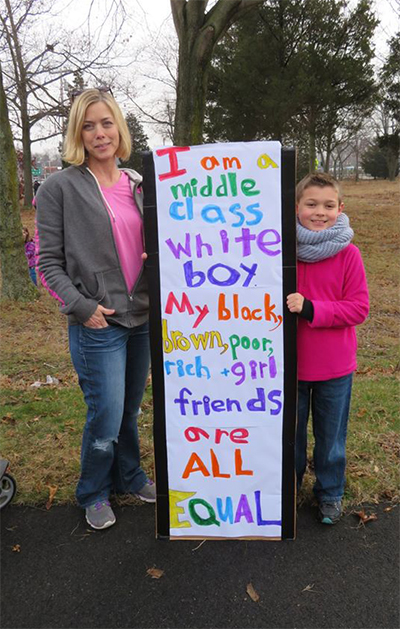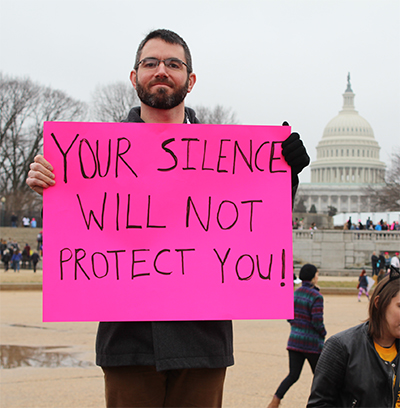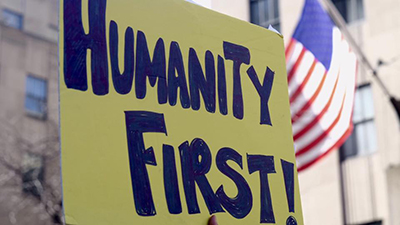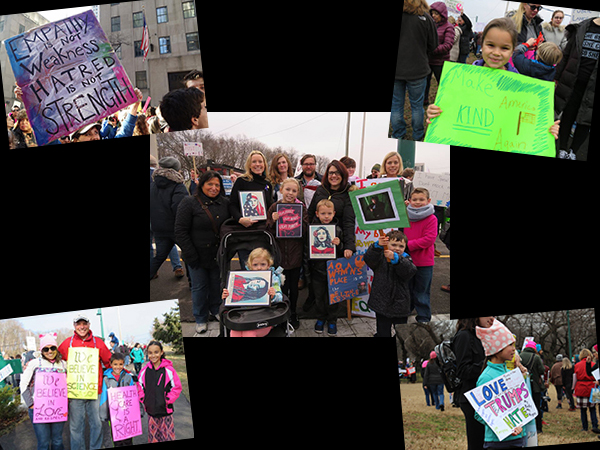 |
Photos from the Women's March and Sister Marches show a diversity of participants and interests. (photo by Gayle Sheridan at NYC Sister March) |
“I don’t know what marching around in the streets accomplishes.”
Anti-marching memes made the rounds on social media after the January 21 Women’s March on Washington and Sister Marches around the globe.
What do marches, rallies and protests accomplish? Ever since the Boston Tea Party, marches, rallies and protests have directly led to some of the most progressive advances in our history:
- Civil rights
- Suffrage and women’s rights
- Labor rights
- Gay rights
- Anti-war and anti-globalization movements
 |
The Long Island Unity Rally was held on January 19 and was attended by Kevin Peterman. |
FA officers and members attended several of the late January public protests in the region, beginning with Kevin Peterman’s attendance at the Long Island Unity Rally held on January 19 outside the LGBT Network Center in Bay Shore. The event was promoted among local unions by the Long Island Federation of Labor and featured about a dozen speakers addressing the concerns of attendees.
The event was sponsored by a broad coalition of social justice organizations. Just look at the various groups who worked together on that rally: Artists Action Group, Action Together Long Island, Communication Workers of America, Food and Water Watch, LGBT Network, LI Activists, Long Island Jobs with Justice, Long Island Progressive Coalition, Long Island Transgender Advocacy Coalition, MoveOn.org, National Institute for Reproductive Health, National Organization for Women, NYS Nurses Association, and Planned Parenthood.
 |
The author and her son, whose sign was taller than he is. (photo by Sarah Kain Gutowski at Port Jeff Sister March) |
On January 21, I attended the Women's March Sister March in Port Jefferson with my eight-year-old son Kai and was happy to see several colleagues from SCCC, including Sarah Kain Gutowski (and her children Lisbeth, Joshua and Niko), Adam Penna (with his partner Shannon Mowdy and their children Sae, Egret and Joel), Lizzie McCormick (and her son Jack), Nina Leonhardt, Lynn Liebert Marx and Karen Dovell.
The people were energized and vocal and their signs were terrific, which opened opportunities to talk with our children about the broad range of reasons why people were there, which covered a host of social justice issues.
Our incoming adjunct coordinator Kevin McCoy as well as FA member Gayle Sheridan attended the Sister March in NYC. “It was wonderful to see so many people come together, in solidarity, to stand up and have their voices heard,” she noted. “The diversity of participants was astounding. It's impossible to identify all the groups that participated, but the photos show it.”
FA Grievance Officer Dante Morelli was at the Women’s March on Washington, which drew at least 470,000 people according to the New York Times and is “…likely the largest single-day demonstration in recorded U.S. history” by Erica Chenoweth and Jeremy Pressman in a February 7 Washington Post article, with the best estimate of 4.2 million people marching in the D.C. Women’s March plus the 600 Sister Marches across the nation.
While Morelli is proud to have been at the historic event, he cautioned, “The March in Washington was a beautiful demonstration of solidarity—but our energy and cause must continue to fight for basic human and labor rights.”
So, reflecting on what marches, protests and rallies accomplish, several things come to mind.
- Protesting exercises one of our most basic First Amendment freedoms. “Congress shall make no law respecting an establishment of religion, or prohibiting the free exercise thereof; or abridging the freedom of speech, or of the press; or the right of the people peaceably to assemble, and to petition the Government for a redress of grievances.”
 |
Jeffrey Wickersham, partner of Dante Morelli, makes plain why we march. (photo by Dante Morelli at D.C. Women's March) |
Protesting is patriotic, and the Women’s March and Sister Marches were absolutely notable for being peaceable assemblies, with police presence summoned only for medical concerns. The diverse men and women with diverse concerns made their voices heard loudly, clearly and calmly.
- Protesting shines a spotlight on issues of concern. It disrupts complacency and helps educate others simply by forcing the question “why are they marching?”
Elie Wiesel said, “There may be times when we are powerless to prevent injustice, but there must never be a time when we fail to protest.” By protesting, by marching, we raise awareness of the injustice and give it voice.
-
 |
This signs gets right to the point. (photo by Gayle Sheridan at Sister March NYC) |
Protesting bonds participants in solidarity. Given the range of causes in speeches and on signs that we FA members witnessed—from reproductive rights to LGBTQIA rights, immigrant rights to civil rights, anti-capitalism to science and the environment—marching together in the streets offers tangible evidence that we can meet together and work collectively for positive change.
- Protesting demonstrates that citizens are not apathetic to the political process. It reminds politicians that we are watching and we will fight for change. We’re all familiar with the democratic changes in Tunisia thanks to the Arab Spring in 2010 and with how Occupy Wall Street put “the 1%” and “the 99%” into our everyday vocabulary.
Think about how many times you see in the headlines that the egregious actions of an elected official caused them to step down due to public outcry, public outrage, public pressure, uproar or controversy. Lesser-known and more recent examples show the power of the people’s voice:
- “A Michigan Republican has resigned after causing outrage by suggesting that protesters at University of California, Berkeley, should be shot” February 9, 2017
- “Republican bill to privatize public lands is yanked after outcry” February 2, 2017
- “An outspoken Nebraska state legislator has resigned following an uproar over a tweet he sent that implied women's march protesters were too unattractive to be victims of sexual assault” January 25, 2017
- “After Public Outcry, House GOP Backtracks on Move to Gut Ethics Office” January 3, 2017
- “Oklahoma state Rep. Dan Kirby abruptly resigned Friday night after three days of public outrage” December 3, 2016
- “The mayor of a West Virginia town resigned Tuesday amid fallout from a racist post on Facebook about First Lady Michelle Obama” November 15, 2016
- “Tom Angel resigns after controversy over racist, anti-Muslim emails” May 1, 2016
- “Calls grow for federal judge in Alabama to resign after domestic violence incident” September 30, 2014 (editor's note: in this particularly egregious case, Fuller finally resigned August 1, 2015)
We the people are watching and we can and should make our voices heard—no matter who is in office. They are there to represent us.
If you don’t agree with the message of the march, do not march. That’s your right.
But don’t denigrate those who are marching. They are exercising their First Amendment right—and marching literally has changed the course of American history.
 |
In center photo is a group of SCCC faculty, including Sarah Kain Gutowski, Nina Leonhardt, Lizzie McCormick, Adam Penna and Cynthia Eaton, along with their children. The presence of children at many of the marches gave people a sense of hope—that children are learning the value of exercising their First Amendment rights from an early age.
(credits: center photo by Shannon Timoney in Port Jeff; top left Gayle Sheridan in NYC, top right by Cynthia Eaton in Port Jeff, bottom right by Dante Morelli in DC, bottom left by Cynthia Eaton in Port Jeff) |
|






